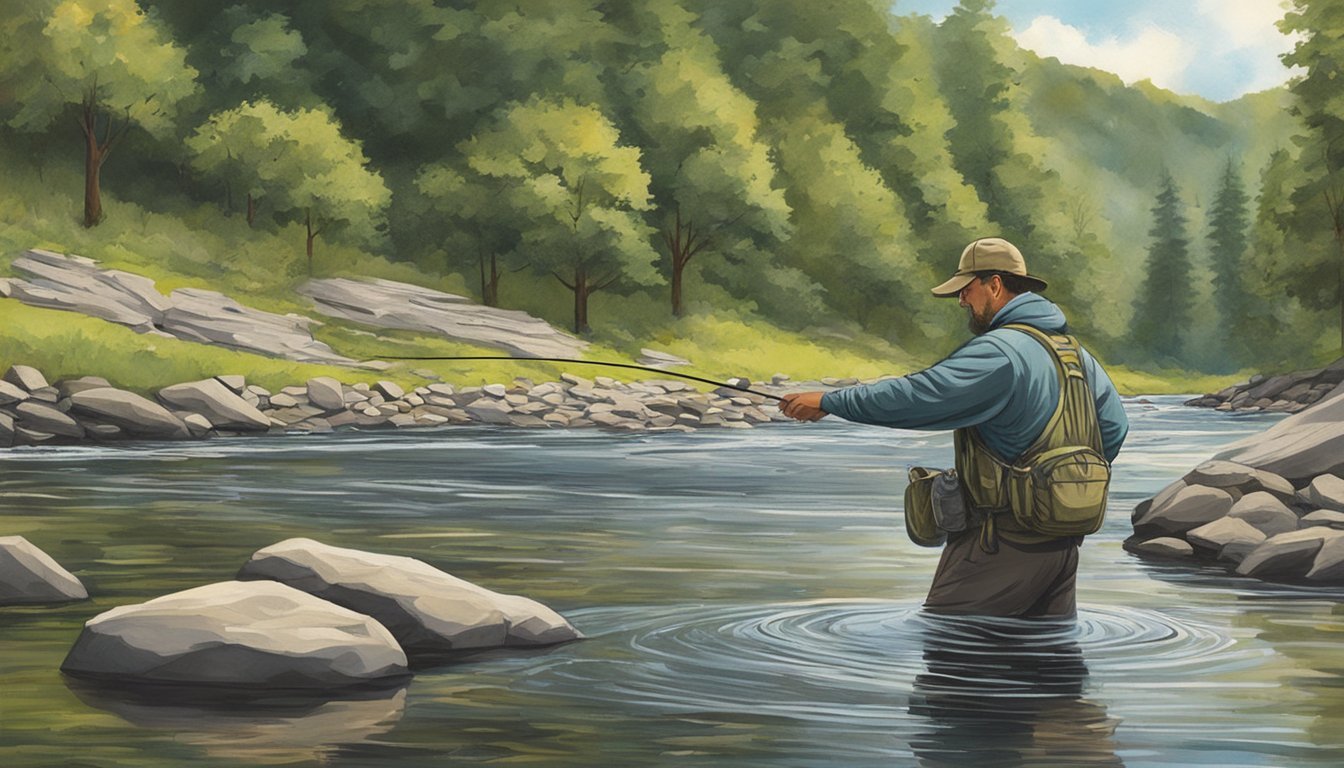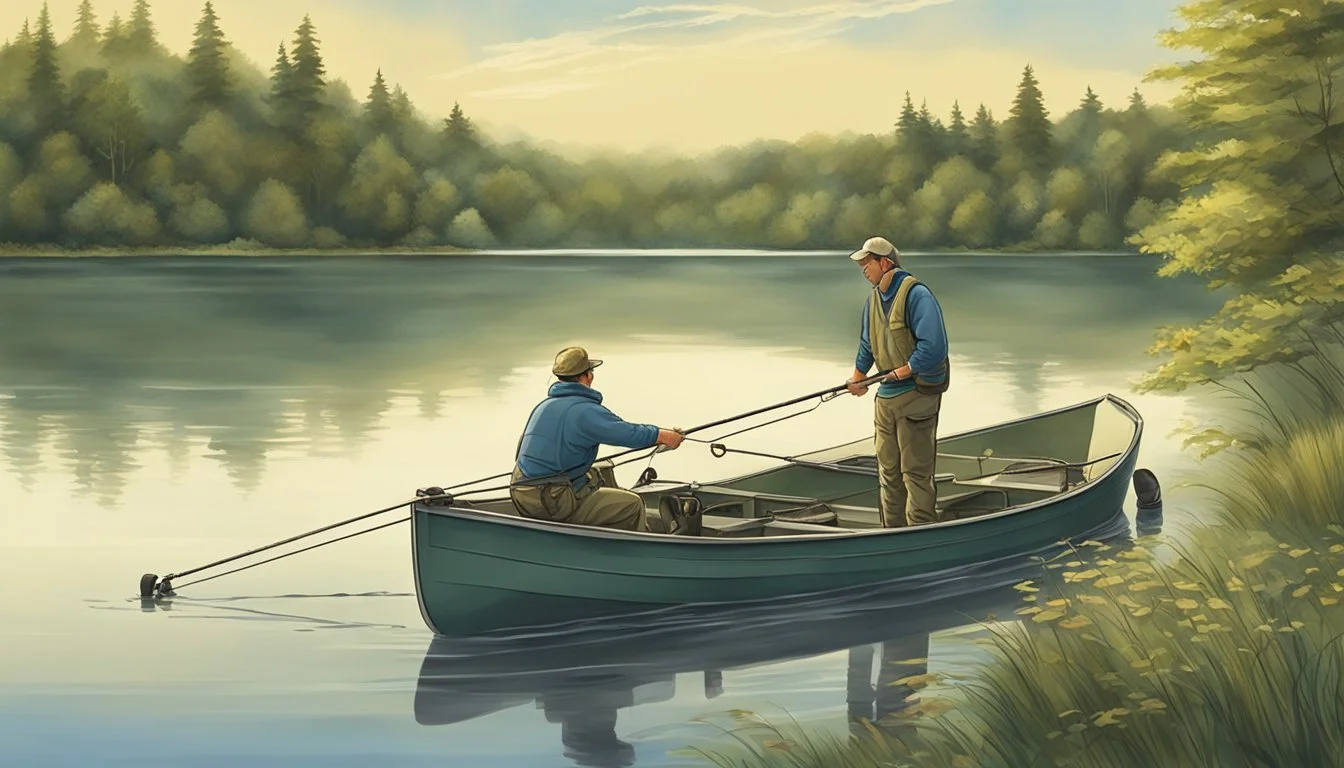Best Fish to Catch and Eat in Pennsylvania
A Guide to the Keystone State's Tastiest Species
Pennsylvania offers a diverse array of freshwater fishing opportunities, boasting an impressive variety of fish (What wine goes well with fish?) species ripe for capture and culinary enjoyment. With an extensive network of rivers, streams, and lakes, anglers can find both the challenge of the catch and the reward of a fresh meal. The state is well-known for its sustainable stocking program and management of fish populations, ensuring that both the casual and the serious angler can enjoy the bounties of Pennsylvania's waters while adhering to conservation principles.
Among the most sought-after species are the Bluegill, known for its mild, sweet flavor, and the various Trout species flourishing in Pennsylvania's cold water habitats. Lake Erie, for instance, provides an ample population of Lake Trout, adding a prized catch for those seeking a rich, oily fish ideal for various cooking methods. On inland waters, the Trout and Bluegill populations are complemented by Walleye and Crappie, especially from the ice-covered expanses of Lake Arthur during the winter months, offering a year-round fishing prospect for enthusiasts.
For those looking to both catch and consume their freshwater fish, Pennsylvania's waters deliver not just variety but also the scenic beauty and accessibility that make the fishing experience both enjoyable and convenient. The state's commitment to maintaining the habitat and health of fish species means that anglers can anticipate a successful outing filled with the promise of a delicious, locally-caught meal.
Understanding Pennsylvania's Aquatic Landscape
Pennsylvania's diverse aquatic landscape, governed by precise seasons and regulations, offers an array of fish species across its numerous water bodies and ecosystems.
Key Water Bodies in Pennsylvania
Pennsylvania's water bodies range from Lake Erie in the northwest to the Delaware River bordering the eastern edge. Lakes such as Raystown Lake, Lake Arthur, and the Pymatuning Reservoir offer excellent angling experiences. Rivers, including the Allegheny, Susquehanna, and Schuylkill, along with streams like Yellow Breeches Creek and Spring Creek, form the state's rich freshwater systems. Presque Isle Bay, by Lake Erie, and Conneaut Lake, Pennsylvania's largest natural lake, are also noteworthy locations for fishing.
Habitats and Ecosystems
Pennsylvania's aquatic habitats host diverse ecosystems—ranging from the lush forests surrounding Moraine State Park to the submerged aquatic vegetation found in shallow bays. These habitats, like those around Oil Creek and in the Allegheny Reservoir, provide ideal conditions for a variety of game fish, creating a dynamic environment for both novice and expert anglers.
Pennsylvania's Fishing Seasons
Year-round fishing is available, with each season presenting unique opportunities. Ice fishing is popular in winter, specifically in the northern part of the state. Warm months, often considered prime time for fishing, extend from early summer to fall with conditions favoring most species. The Pennsylvania Fish and Boat Commission provides detailed seasonal guides for the best fishing experiences across the state.
Season Conditions Notable Activities Winter Ice-covered lakes Ice fishing in northern lakes Spring Water bodies thaw Trout season begins Summer Warmest waters Ideal for bass, walleye, and panfish Fall Transitioning temperatures Hearty bites pre-winter
Fishing Regulations and Conservation
Fishing regulations in Pennsylvania are set to maintain fish populations and their habitats. Regulations vary by waterway and often stipulate catch and release for certain species and minimum size limits. The Pennsylvania Fish and Boat Commission oversees these rules including specific game fish stipulations. Catch and release areas, designed to conserve fish populations, can be found in various locations, and fishing licenses are required for anglers aged 16 and over. Regulations are regularly updated to reflect ecological needs and population management goals.
Key Fish Species and Their Habitats
Pennsylvania offers a diverse range of habitats supporting a variety of sought-after game fish. From the cold, pristine waters suited for trout varieties to the warm lakes ripe for bass fishing, anglers can find species to target throughout the state.
Trout Varieties in Keystone State
Pennsylvania is renowned for its abundance of trout, which thrive in the state's many coldwater streams and rivers. The brook trout, Pennsylvania’s state fish, is a native species often found in smaller streams. Brown trout and rainbow trout, while not native, have become well-established since their introduction. They can be found in larger streams and rivers and are common targets for both novice and experienced anglers. Many waters are also stocked with trout, providing ample opportunity for successful fishing trips.
Brook Trout: Prefers clear, cold, well-oxygenated streams and ponds.
Brown Trout: Adaptable, thriving in various freshwater habitats but favoring larger streams and rivers.
Rainbow Trout: Often found in cool, clear rivers with strong currents and gravel bottoms.
The Popular Bass Family
Bass fishing is a favorite pastime in Pennsylvania, with both smallmouth and largemouth bass widely distributed in the state's water bodies. Smallmouth bass are often associated with rocky habitats of flowing waters such as rivers and large creeks, where they provide spirited action for anglers. Largemouth bass, conversely, prefer warmer, more vegetated waters like lakes and ponds, and they are known for their aggressive strikes and strong fights when hooked.
Smallmouth Bass: Encounter them in rivers and streams with clearer water and rocky substrates.
Largemouth Bass: Look for them in sluggish or standing water with abundant plant life and soft bottoms.
Other Notable Game Fish
Pennsylvania's fishing scene is also highlighted by a variety of other key species, each favoring different habitats. Walleye and Northern Pike frequent the deeper and cooler parts of large lakes and rivers. Anglers often target Channel Catfish in warm, slower-moving sections of streams and rivers. The state's many lakes are rich with panfish such as Bluegill, Black Crappie, and Yellow Perch, which are popular for their ease of capture and excellent taste. The elusive Muskellunge, or Musky, provides a challenge for those seeking large, aggressive sportfish.
Walleye: Deep areas in lakes and large rivers with moderate current.
Northern Pike: Weedy places in lakes or slow-moving rivers; can tolerate brackish water.
Channel Catfish: Prefer complex habitats in warm, muddy, or turbid waters.
Panfish: Shallow waters near cover such as logs, rocks, or vegetation.
Muskellunge: Solitary predators found near cover in clear lakes and flowing waters.
Effective Fishing Techniques and Tackle
Selecting the appropriate bait and gear is crucial for a successful fishing experience in Pennsylvania. The choice depends on the targeted species, whether it is trout, smallmouth bass, or largemouth bass.
Bait and Lure Selection
When targeting trout in Pennsylvania, common live baits such as worms and minnows are highly effective. Anglers often employ corn or specialized baits like PowerBait in various situations. For those aiming for smallmouth or largemouth bass, a combination of spinners, crankbaits, and other lures can be key to enticing these fish.
Trout: Worms, Salmon Eggs, Corn, PowerBait
Smallmouth Bass: Crankbaits, Spinners
Largemouth Bass: Rubber Worms, Jigs
Using the Right Fishing Line and Gear
The line's weight and strength should match the targeted fish species and the environment. A lighter line is typically suited for trout fishing, while heavier lines are necessary for bass fishing to handle their aggressive fight. The right net and boat can also greatly impact the success rate.
Line for Trout: 4-6 lbs test
Line for Bass: 8-20 lbs test
Boats: Adequate size for the water body; maximum horsepower for larger lakes
Advanced Angling Strategies
Seasoned anglers use specific strategies for different species. For trout, drift fishing using natural current can improve catch rates. In bass fishing, understanding the behavior and seasonal patterns of fish leads to better lure presentation and increased chances of a catch. It's important for anglers to adapt their tactics based on the fish's activity level and feeding habits.
Trout Fishing: Drift fishing, using current for natural bait presentation
Bass Fishing: Knowledge of behavior and patterns, adapting lure type and retrieval technique based on conditions
Fishing Spots and Destinations
Pennsylvania offers a wide array of scenic fishing destinations, from the tranquil banks of creeks and rivers to the expansive waters of great lakes. These spots not only provide excellent opportunities for anglers but also feature picturesque scenery.
Fishing Hotspots in Allegheny
Allegheny River: Renowned for its vibrant fishing scene, the Allegheny River harbors a diversity of fish including walleye, northern pike, and bass. Anglers frequent its waters for the thrill of catching trophy-sized specimens. Moraine State Park: Lake Arthur, nestled within Moraine State Park, boasts abundant species such as largemouth bass and channel catfish. With its 9 public boat launches, it remains a favorite for fishing enthusiasts.
Lake Erie and Surrounding Waters
Lake Erie: Recognized as one of Pennsylvania's premier fishing locations, Lake Erie excels with a rich population of smallmouth bass. Its clear, deep waters are also home to trophy-sized fish and the fourth-largest of the Great Lakes provides unmatched big bass fishing experiences. Presque Isle Bay: An extension of Lake Erie, Presque Isle Bay also presents a charming spot teeming with panfish, bass, and muskellunge among other species. Its accessible piers and boat landings add to its allure for anglers.
Rivers and Creeks for Trout and Bass
Susquehanna River: The Susquehanna River is a hotspot for smallmouth bass. The river's flow offers a challenging yet rewarding experience for anglers seeking these game fish. Oil Creek: Known for its historical significance, Oil Creek also provides serene spots for trout fishing, particularly appealing to those seeking the tranquility of nature alongside their angling adventure.
Discovering Other Noteworthy Locations
Raystown Lake: As the largest lake wholly within Pennsylvania, Raystown Lake is a haven for striper and bass fishing. Yellow Breeches Creek: Ideal for fly-fishing, Yellow Breeches Creek hosts a healthy trout population that draws anglers year-round. Conneaut Lake: This natural lake, the largest in Pennsylvania, is praised for its fishing, particularly for bass and bluegill.
Planning Your Fishing Trip
When planning a fishing trip in Pennsylvania, one should be cognizant of the statewide regulations that govern fishing seasons, consider safety measures, and explore the various accommodations and amenities available near major fishing destinations like Harrisburg, Pittsburgh, State College, Reading, and Philadelphia.
Safety and Preparation Tips
Check Regulations: Always consult the Pennsylvania Fish and Boat Commission for the latest fishing regulations, including seasons, size limits, and permitted gear.
Gear and Equipment: Ensure that your fishing gear is suitable for the species you’re targeting, whether it's in rivers, streams, or lakes. Pack a first aid kit, life jackets, and appropriate clothing for changing weather conditions.
Local Fishing Guides and Resources
Sources of Information: Local bait shops and fishing clubs are excellent sources for up-to-date information on fishing hotspots and species presence.
Hiring Guides: For newcomers or those seeking expertise, local guides can enhance the fishing trip experience, particularly in popular areas such as Lake Erie or the Susquehanna River near Harrisburg.
Accommodations and Amenities
Lodging: Accommodations range from camping sites near natural streams in State College to hotels in metropolitan areas like Philadelphia.
Amenities: Many fishing locations are near towns that offer dining, entertainment, and other conveniences, adding comfort to your trip.
The Role of Fishing Communities and Events
In Pennsylvania, fishing communities and the events they host are the backbone of the local angling scene, fostering camaraderie and conservation efforts.
Fishing Clubs and Organizations
Pennsylvania's fishing clubs and organizations play a pivotal role in uniting anglers with a common passion for fishing. These groups often work in collaboration with the Pennsylvania Fish and Boat Commission to promote sustainable fishing practices and to ensure the health of the state's aquatic ecosystems. For example, Trout Unlimited chapters across Pennsylvania focus on trout habitat conservation and restoration, thus contributing significantly to both the sport and the environment.
Key functions of fishing clubs and organizations include:
Education: Offering workshops and seminars on topics like species-specific tactics and waterway stewardship.
Conservation: Participating in and leading habitat improvement projects.
Competitions and Social Gatherings
Competitions and social gatherings, such as the Mentored Youth Trout Day, are essential for fostering a sense of community and sportsmanship among Pennsylvania anglers. Annual events not only encourage experienced fishermen to connect and share knowledge but also provide an avenue for novices to learn and partake in the fishing culture.
Highlights of fishing-related events:
Tournaments: Competitions for various species, promoting both sport and conservation.
Community Events: Including family-friendly fishing days and educational outings.
Impact: These events often raise awareness of the importance of preserving Pennsylvania's waterways and fish populations, while also being a driver for local economies through tourism and related activities.
Conservation Efforts and Sustainable Practices
In Pennsylvania, significant efforts are underway to protect aquatic ecosystems and ensure the sustainability of the state's fisheries. Consistent habitat restoration, stringent regulatory measures, and a commitment to environmental stewardship are key to preserving Pennsylvania's fishing heritage.
Habitat Restoration Initiatives
Pennsylvania's conservation groups are actively engaging in habitat restoration to support ecosystems vital for fishing. The Alliance for the Chesapeake Bay, for instance, works to install agricultural best management practices on farms within Lancaster and Lebanon counties, aiming to improve water quality. Another conservation body, the National Fish and Wildlife Foundation (NFWF), in partnership with EPA and the Chesapeake Bay Program, has allocated $2.5 million for projects enhancing the Chesapeake Bay watershed.
Key restoration activities:
Installing riparian buffers to reduce runoff.
Conducting freshwater mussel surveys to understand river health.
Creating wetlands for natural water filtration.
Regulatory Measures and Impact
Pennsylvania's Department of Environmental Protection ensures that fishing regulations align with conservation goals. These include limits on catch sizes and numbers, designated fishing seasons, and catch and release policies to minimize the impact on fish populations. Regulations also restrict activities that harm habitats, like the release of pollutants or unsustainable farming practices that result in harmful runoff.
Impact of regulations:
Protection of fish populations and habitats.
Balancing ecological needs with fishing interests.
The Importance of Environmental Stewardship
Environmental stewardship is paramount in Pennsylvania, where conservation is not just a regulatory issue but a community responsibility. Local organizations encourage public participation in conservation efforts, educating anglers about the importance of respecting ecosystems and promoting sustainable fishing practices.
Stewardship practices:
Encouraging the use of eco-friendly tackle.
Promoting awareness of invasive species.
Facilitating community cleanup events to maintain habitat cleanliness.





